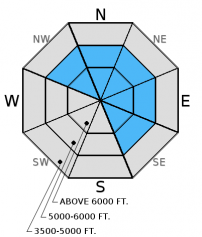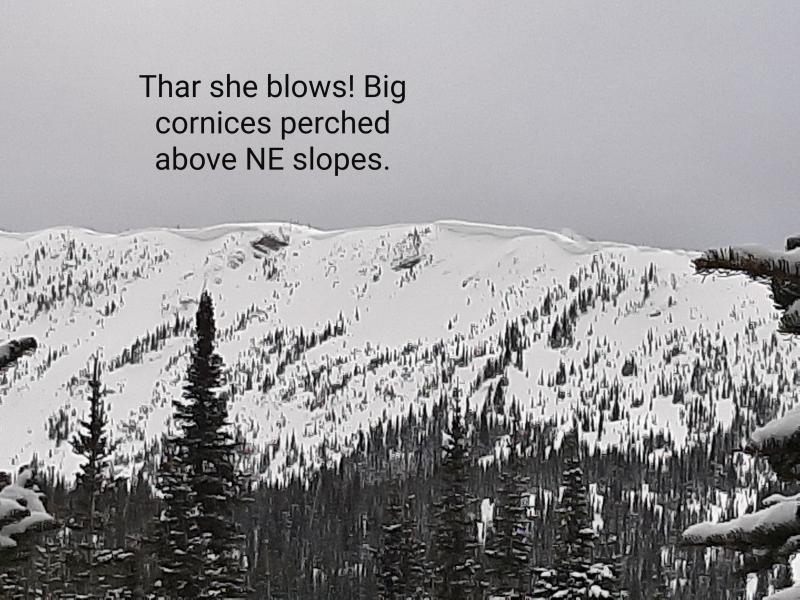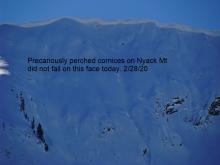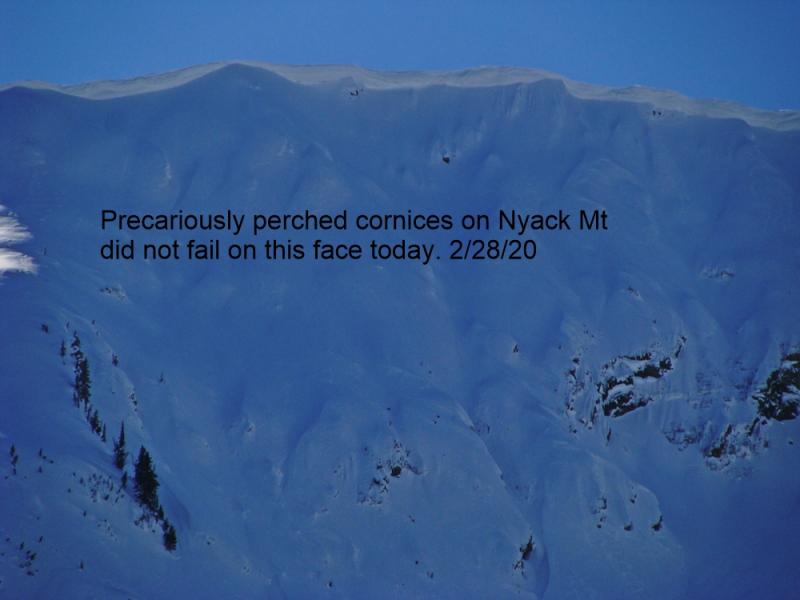| Thursday | Thursday Night | Friday | |
|---|---|---|---|
| Cloud Cover: | Mostly clear with warm temperatures. High clouds in the afternoon. | Partly cloudy. | Sunny with well above normal temperatures. |
| Temperatures: | 35-43 deg. F. | 23-29 deg. F. | 39-48 deg. F. |
| Wind Direction: | Southwest | Southwest | South-Southwest |
| Wind Speed: | 6-10 mph with gusts to 23 mph. | 8-11 mph with gusts to 23 mph. | 7-12 mph with gusts to 26 mph. |
| Snowfall: | 0 in. | 0 in. | 0 in. |
| Snow Line: |
Whitefish Range
Swan Range
Flathead Range and Glacier National Park
How to read the forecast
Lingering wind slabs at upper elevations continue as our main concern today. Human triggered avalanches are possible and you are most likely to trigger an avalanche in upper elevation wind loaded terrain. Increasing sunshine and warming will weaken the snow surface later in the day creating loose, wet avalanche potential. Evaluate snow and terrain carefully. The danger is MODERATE above 5000 feet. Below 5000 feet the danger is LOW.

2. Moderate
?
Above 6500 ft.
2. Moderate
?
5000-6500 ft.
1. Low
?
3500-5000 ft.
- 1. Low
- 2. Moderate
- 3. Considerable
- 4. High
- 5. Extreme
-
Type ?
-
Aspect/Elevation ?

-
Likelihood ?CertainVery LikelyLikelyPossible
 Unlikely
Unlikely -
Size ?HistoricVery LargeLargeSmall

Wind speeds diminished across our advisory area yesterday and overnight. However, winds earlier this week moved last weekends low density storm snow creating wind slabs on leeward slopes. These wind slabs continue to gain strength but lingering instabilities remain. With a lack of overnight weather station data from southern Glacier Park fresh wind slab development cannot be ruled out in the usual favored wind locations. Regardless, with the amount of wind loading that has occured this week, treat all wind loaded terrain as suspect. Numerous parties Tuesday reported active wind loading in the Flathead Range (photo). Look for rounded pillows of wind drifted snow on leeward sides of ridges and cross-loaded areas in gullies at both mid and upper elevations. Carefully evaluate all wind loaded terrain before committing to a slope.
-
Type ?
-
Aspect/Elevation ?

-
Likelihood ?CertainVery LikelyLikelyPossible
 Unlikely
Unlikely -
Size ?HistoricVery LargeLargeSmall

Clear skies last night allowed temperatures to drop below freezing at all elevations producing a hard freeze of the snow surface. However, with abundant sunshine and above normal temperatures on tap, loose wet avalanches are possible on sunny aspects at all elevations later today. This problem will be of greater concern today and tomorrow than it has been over the past few days. Early signs that the surface snow is becoming unstable are roller balls and pinwheels. Pay attention to these changing conditions and move onto more shaded terrain.
-
Type ?
-
Aspect/Elevation ?

-
Likelihood ?CertainVery LikelyLikelyPossible
 Unlikely
Unlikely -
Size ?HistoricVery LargeLargeSmall

Large cornices exist throughout the advisory area. These cornices can fail naturally during periods of warming. The weight of a cornice failure can trigger an avalanche on the slope below. A large avalanche in the Lost Johnny drainage of the northern Swan Range this weekend is a good example (observation). With sunshine and warming temperatures on tap for the next few days cornices will weaken and cornice failure will be possible.
This season we dealt with an ever evolving persistent slab problem associated with widespread rain crusts and weak snow surrounding these crusts. As time has passed so has our concern with some of these rain crusts. Currently, we are still tracking the strength of the snow around the January 28 and February 14 crusts. The Valentine's Day crust now has 1.5-3 feet of snow sitting on top of it. In recent observations we found a thin layer of facets above this crust. While it took hard force to initiate fracture, it propagated across the column in our stability tests last Thursday (video). Keep in mind that even small avalanches can step down into this deeper layer.
As our mid winter snowpack transitions into a spring snowpack glide cracks are beginning to form. On Monday we observed a recently formed glide crack in the Kimmerly Basin area of the southern Whitefish Range, and others have reported isolated areas with glide cracks (observation). Glide avalanches are notoriously difficult to predict. It is best to simply avoid slopes with glide crack present (photo).
Wednesday: Skiers in the southern Whitefish Range reported widespread surface hoar development, new glide cracks that have formed and minimal solar affect on sunny aspects (observation, observation).
Tuesday: Snowmobilers in the Stahl Peak area in the northern Whitefish Range observed recent avalanche activity within the past 4 days. One slide was suspected to be machine triggered (observation). BNSF Avalanche Safety noted active wind loading in southern Glacier Park yesterday. Two separate parties of skiers in the Middle Fork corridor observed substantial wind loading at upper elevations (photo) while skiers in the northern Swan Range reported calm winds at ridgetop locations.
Monday: We traveled to Kimmerly Basin in the southern Whitefish Range where we found cohesive snow on wind loaded aspects. While skiing on this snow we observed localized cracking and were able to initiate small wind slab avalanches. We also noted large cornice development with numerous small cornice failures and a large glide crack (observation). Snowmobile observers traveled to Red Meadow in the northern Whitefish Range and Werner Peak in the southern Whitefish Range. They found evidence of recent wind loading and wind slab avalanches (observation).
Sunday: Snowmobilers in the Lost Johnny drainage of the northern Swan Range noted a large natural slab avalanche that appears to have been triggered by a cornice fall (observation). Skiers in Spider Bowl in the northern Swan Range noted lots of sluffing of the new snow on steep upper elevation slopes, southerly aspects becoming sun affected as the day progressed and only minimal new snow on a crust at 5000 feet. Skiers in the Marion Lake area of the Flathead Range reported south facing slopes being sun affected with a 1/2 inch thick crust by late afternoon but good snow quality and no signs of instability while skiing north aspects.
Saturday: There were two close calls in the advisory area last Saturday. A skier was caught in a thin slab avalanche adjacent to the Whitefish Mountain Resort boundary and was carried an estimated 500 feet (observation). This individual triggered the slide 2 or 3 turns into their run from a ridgeline. Fortunately only minor injuries were sustained. A snowboarder in the Cascadilla Drainage in the Flathead Range triggered a slab avalanche and was able to ride out (observation). The great snow quality lured a lot of folks out last weekend and we received many great observations (observations).
Visit our Observations page and our You Tube channel for more observations from the entire season.
Thanks to everyone for submitting observations. They are extremely useful and could help save lives.
HOW TO SUBMIT OBSERVATIONS:
Email: [email protected]
Call and leave a message: 406.387.3821
You can also submit quick observations via text: 406.241.4571 (FAC mobile)
OR
Submit Snowpack Observations: http://www.flatheadavalanche.org/node/add/snowobs
Submit Avalanche Observations: http://www.flatheadavalanche.org/node/add/avyobs
High pressure will be the dominant feature for the next 2 days. Skies cleared overnight and a slight temperature inversion has formed. Today will be the warmest day we have experienced this week with tomorrow being even warmer. As of 6:00 a.m.temperatures above 6000 feet range from 15º-31º F and winds are generally out of the southwest at 3-9 mph gusting to 12 mph. Today, temperatures will rise to the mid to upper-30s F with high clouds moving in later this afternoon. Winds will move mostly out of the west-southwest today at 10-15 mph with moderate gusts in the Swan Range and strong gusts in the Flathead Range. Note: Several of our weather stations have not reported since noon yesterday. Therefore we do not have upper elevation wind or temperature data from southern Glacier Park.
| 0600 temperature: | 15-31 deg. F. |
| Max. temperature in the last 24 hours: | 33-36 deg. F. |
| Average wind direction during the last 24 hours: | Southwest |
| Average wind speed during the last 24 hours: | 1-14 mph |
| Maximum wind gust in the last 24 hours: | 11-15 mph |
| New snowfall in the last 24 hours: | 0 inches |
| Total snow depth: | 75-99 inches |
This advisory applies only to backcountry areas outside established ski area boundaries. This advisory describes general avalanche conditions and local variations always occur. This advisory expires at midnight on the posted day unless otherwise noted. The information in this advisory is provided by the USDA Forest Service who is solely responsible for its content.






































